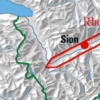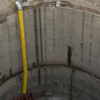Overview
Dr. Jorj O. Osterberg, Professor Emeritus of Civil Engineering at Northwestern University, invented and developed a deep foundation load testing device to meet the construction industry’s need for an innovative effective method for testing high capacity drilled shafts and piles. Osterberg’s invention, the Osterberg Cell, commonly called the “O-cell” by the industry, has radically changed the way foundation load tests are designed, performed and interpreted.
The O-cell is a hydraulically driven, high capacity, sacrificial jacking device installed within the foundation unit. Working in two directions, upward against side-shear and downward against end-bearing, the O-cell automatically separates the resistance data.
By virtue of its installation within the foundation member, the Osterberg Cell load test is not restricted by the limits of overhead structural beams and tie-down piles. Instead, the O-cell derives all reaction from the soil and/or rock system. End bearing provides reaction for the side shear portion of the Ocell load test, and side shear provides reaction for the end bearing portion of the test. Load testing with the O-cell continues until one of three things occurs: ultimate side shear capacity is reached, ultimate end bearing capacity is reached, or the maximum O-cell capacity is reached.
Loadtest specializes in bi-directional deep foundation load testing using the award winning Osterberg cell. Founded in 1991 they have conducted over 600 load tests, redefining the Art of Load Testing along the way.
What We Did
Successful load testing using the O-cell requires precision monitoring of numerous test parameters. These include concrete strain using strain gages, compression using telltale rods, shaft movement using displacement transducers and load, by way of hydraulic pump pressure monitoring using pressure transducers. Canary Systems has supplied numerous MultiLogger systems as well as MultiMux Instrument Multiplexers to Loadtest to support their simultaneous projects.
Canary Systems developed custom hardware and software to support the demanding requirements of the monitoring program. For example, Canary Systems developed an interface to the MultiLogger System for the digital version of the displacement transducers for monitoring the telltale rods and shaft movement. These indicators, manufactured by Chicago Dial Indicator, include an integrated LCD display for manual recording of displacements in addition to the automated recording. Canary Systems also developed the software interface, using DDE linking, between the MultiLogger Software and Microsoft Excel. Loadtest has developed, using Microsoft Excel, a comprehensive reporting system that can be utilized during the test to evaluate shaft performance. MultiLogger operating in the monitor mode supplies Excel with the data in real-time to automatically update the reporting system during the test.


